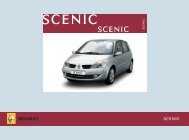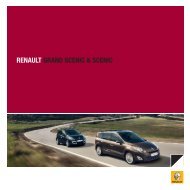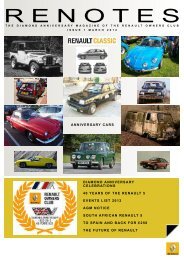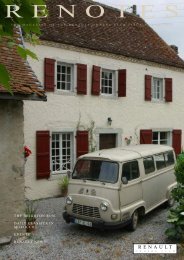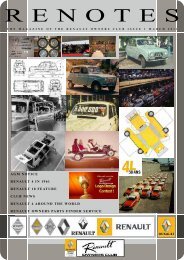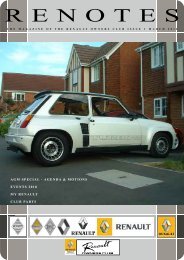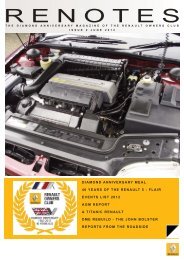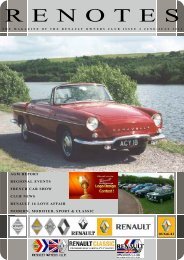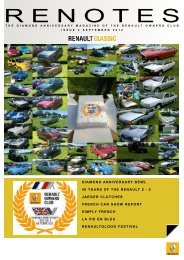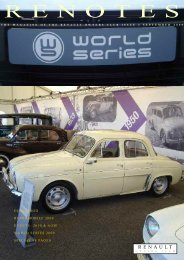C L A s s I C - A N N I V E R s A R I E s - C o L o R A L EColorale 60 th Anniversary<strong>2010</strong> sees the 60th anniversary ofthe launch of one of <strong>Renault</strong>’s leastknown range of models – certainlyas far as anglophone markets areconcerned – the Colorale family. Indeed,there is some confusion about its propernomenclature. ‘Colorale’ (an amalgamationof ‘Coloniale’ and ‘Rurale’, which is selfexplanatory)is the range’s family name(surname) and ‘Prairie’, ‘Savane’, ‘Taxi’and others are the model names(given/Christian names, as it were). Bychance, the range might have been named‘Pastorale’ or ‘Tropicale’, but the eventualchoice of ‘Colorale’ had a pleasant ring anda tenuous sound association with theAmerican world ‘corral’ (an enclosure intowhich [generally] cattle are herded), whichis a tangental compliment to the vehicle’sorganic ancestor, the station wagon of theAmerican mid West farming way of life.History records that there were twopassionately defended faiths espoused by,on the one hand, the Louis <strong>Renault</strong>-reared‘old guard’ and, on the other, the moreopen-minded, state-appointed ‘youngsters’of the newly-created RNUR (RégieNationale des Usines <strong>Renault</strong>), of whichPDG Pierre Lefaucheux was the primeexample, over the commercial viability ofthe Colorale range. Those managers, whohad served under the authoritarian Masterof Billancourt (and, indeed, many of theremaining pre-war <strong>Renault</strong> sales agents,too) were heavily influenced by theunequalled and extensive pre-war <strong>Renault</strong>model range, which allowed them to offer a<strong>Renault</strong> model to virtually any possibletype of customer, and they were unable (ordid not want) to countenance making andselling a very narrow range ofcomparatively inexpensive vehicles, whichwas, in reality, all that the majority of animpoverished and war-weary general pubiccould afford at the time.Briefly, Pierre Lefaucheux decided to gofor broke with the 4CV and the rest, as theysay, is history. However, he was not totallyblind to the dangers of a ‘monomarque’culture (which later very nearly scupperedVolkswagen and its Beetle) and he wasaware that the RNUR neither offered a carto <strong>Renault</strong>’s pre-war rural customers stillcruising around in their ancient andunburstable Vivaquatres and Novaquatresnor to business and trades people, forwhom the 300kg Juvaquatre-based van wastoo small and the 1000kg asthmatic butindestructible van was too big. There was,indeed, room for something in between butwas it a viable market for the newlyfoundedRNUR?The ‘old guard’ believed that there wassuch a market and, championed by AlbertGrandjean and Gilbert Lescoat from thecompany’s inner circle, it was suggested, asfar back as 1946, that a ‘station wagon’-type vehicle should be studied, using amaximum of bits from the extensive<strong>Renault</strong> spare parts bin tominimise investment costs.The appearance of theoriginalprototypewas verysimilar to thecontemporaryPlymouth, with‘woodie’ (called‘canadienne’ in French)bodywork. PierreDreyfus, who was tobecome PDG of the RNURupon Pierre Lefaucheux’untimely death in 1955, was one ofthose vigorously opposed to theproject as being non-viable andWoodiebackward-looking, not to mention thatdevelopment resources would be divertedaway from essential work needed toaddress the urgent necessity of developinga larger saloon, that is to say the thencurrent rear-engined Project 108. This wasaborted, late in the day, in favour of theFrégate range - also to be ultimatelydisappointing. However, his fears wereoverruled by the commercial arguments putforward by the Colorale’s supporters.The necessity to minimise unwarranteddevelopment costs led to the adoption ofthe pre-war, indestructible ‘85’ (from its85mm bore). This was a fainthearted petrolengine first seen in the 1936 Primaquatre,which every mechanic in France couldoverhaul blindfolded, and of which wellover a quarter of a million exampleshad been manufactured thitherto.Likewise, the choice of thesturdy, but heavy, chassis ofthe 1000kg smallcommercial would ensuresolidity, as would thesemi-ellipticallysprung one-pieceaxles front andrear. The latterwere assisted byJ. -A Gregoire’svariable flexibilitycorrectors for tropical markets.For the body design, <strong>Renault</strong> tookadvantage of the pertinent expertise of14 R E N o T E s m A G A Z I N ER E N O T E S M A G A Z I N E
C L A s s I C - A N N I V E R s A R I E s - C o L o R A L Ethe large industrial concern, Chausson. Theeventual, co-operative metal-bodied secondprototype allowed a maximum of versionsto be offered with a minimum ofalterations.To make it look like a member of the<strong>Renault</strong> family, Robert Barthaud and histeam reworked the front to resemble the4CV. The interior was comfortable butsimple and somewhat rustic. Three could sit‘up front’ (thanks to the steering columnmountedgear lever),on a two-place benchand a foldable thirdseat, with a three benchseat behind. Moreover,one could fit a crosswiseseventh seatbehind the second row,or remove the backseat altogether, thusoffering a huge loadcapacity.In fact, the Prairie wasarguably the first ever,mass produced voitureà vivre, offeringroominess and versatility. A glazed tailgate,of which the top half hinged upwards andthe bottom half downwards, could be heldhorizontally by means of retaining straps orotherwise swung down to lie completelyflush against the back of the vehicle, thusfacilitating loading or the carriage of extralong objects. Although one or other or acombination of some such features wereoffered subsequently from time to time byother manufacturers (who have often quitewrongly laid claim to have built the first‘multispace’ vehicle), the Colorale range’spolyvalency was way ahead of them all andwas only properly trumped by <strong>Renault</strong>’scommercial interpretation of Matra’sEspace suggestion in the early Eighties.The Colorale range was launched in theBagatelle Park in May 1950 in threeversions. The first was the Prairie, whichwas to prove the most widely sold variantand which was a three-light, five-door,six/seven seat model. Then there was theSavane, a four-light, three-door, six-seater,on which the rear side windows wereabsent and the openings could be coveredwith roll-down canvas side curtains locatedby Dzus fasteners. Moreover, this modeloffered a top-hinged opening windscreen(the wipers on all Colorales had spindles onthe front bulkhead) and was clearly aimedat the tropical francophone colonial market(in the days before vehicle airconditioning!), although a notable numberfound agricultural or artisanal customers onthe home market. The last variant at launch,was the Taxi 85, which was a Prairie withthe necessary modifications to compete inits targeted market. All these models wereType R2090 vehicles.At the following October’s Paris Salon inthe Grand Palais, three further models werelaunched. The first was a Pick-up, aconventional such vehicle, with twosmallish rear-of-cab square windows on thecab’s closing panel, rigid flatbed sides anda drop-down tailgate, offering a natty littlefolding step on its inner face. Whenvertically lowered, this made climbing onto the load surface easier. The second wasan 800kgs Fourgonnette, which looked likethe Savane, but the rear side quarters weresolid panels and there were only three frontseats – a two-place bench and a foldablesingle seat, which could offer additionalcarrying capacity if and when desired, be iteither in weight or extended length terms.The back door was a right-hand hingedsingle piece component. The last variantwas the Chassis-Cab, similar to the Pickup,with the cab ending immediately behindthe two side doors. The shut panel washorizontally contoured and sported thesame little windows to allow rearwardsight, to which structure the manycontemporary commercial coach buildersadded their own (or their clients’ suggested)bodywork. All of these latter variants weredesignated as Type R2091.A significant factor in the pricing must havebeen that, in order not to interfere withBillancourt’s pell-mell production of the4CV, it had been decided to sub-contractthe stamping out of the body panels and theassembly thereof into complete bodyshellsto – whom? To Chausson at Gennevilliers,of course, as that company was, at thattime, the only external French subcontractorpossessing the industrialcapability to produce Colorale shells at theprojected rate of 150 units perday, at which point the projectwould have broken even. Theunpainted body shells weretransported vertically toBillancourt for final fittingout, eight at a time (four oneach side) on speciallyconstructed articulatedtrailers.In April, additional finalassembly was also undertakenat <strong>Renault</strong>’s factory at Haren,in Belgium and, already in itsfirst full season (1951), thePrairie De Luxe was joinedby a Prairie Normale, which was a ‘spartan’version, the price of which approachedmore closely that of the opposition. Tocontinue the publicity, a Savane and a pickuptook part in the Mediterranean-CapeRally and finished 7th and 11th, which wasnot a fine result, but it kept the new rangein the public’s eye. However, after the firstsix months, the range’s success could beestimated and it was not favourable. Forsure, the Prarie was selling into thefinancially comfortable clientele of thelarger agricultural undertakings in the Parisbasin and the north, where its rusticity,reliability, comfort and adaptability wereappreciated, but the necessity to ‘row’ itthrough the gears, led to poor economy,which was not to customers’ liking.R E N o T E s m A G A Z I N E155



